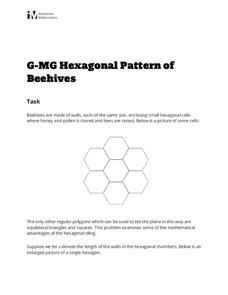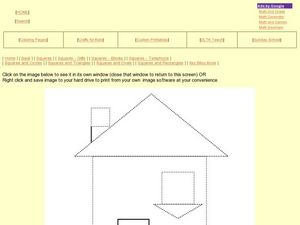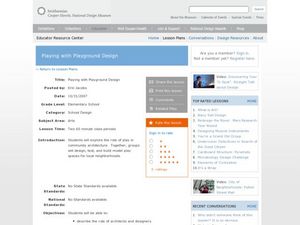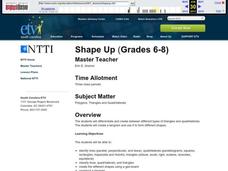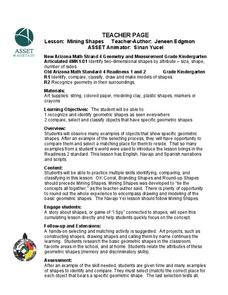Curated OER
African Mask
Students make masks. In this African art lesson, students review background information about African art and the use of masks. Students use geometric shapes and other designs to create their masks.
Curated OER
Abstract Art: Line, Shape And Color
Students define and create an abstract art work. They introduce the artist Piet Mondrian and review geometric shapes (rectangles & squares), straight , angular lines, color.
Curated OER
Mondrian Inspired Abstract Art
Students explore the art of Piet Mondrian. In this abstract art lesson, students look at paintings by the Dutch painter and then follow the provided steps to create their own abstract art inspired by his works.
Curated OER
The Art of Description
Learners apply descriptive language to identify the five elements of art and the basic lines, geometric shapes, and angles in Marie Hull's, Sharecropper. They explain how the elements of a piece of work contribute to the story it tells....
Curated OER
Circles and Squares: Lemonade Picture
In this shapes and colors worksheet, students analyze a picture of a glass of lemonade and trace all the circles and squares. Students color the shapes according to the directions.
Curated OER
Squares and Ovals: Face Picture
For this shapes and colors worksheet, students analyze a whimsical picture of a face and trace all the squares and ovals they see. Students color the shapes according to the directions.
Annenberg Foundation
Geometry 3D Shapes: Platonic Solids
From polyhedrons to platonic solids, here is a lesson that will have your classes talking! As an introduction to platonic solids, scholars cut and fold nets to create the three-dimensional solids. They use an interactive component to...
Annenberg Foundation
Geometry 3D Shapes: Surface Area and Volume
Whether you wrap it or fill it, you're using geometric concepts. Classmates use an interactive approach to learn how to find volume and surface area of cylinders and prisms in the second lesson in a five-part series. The online lesson...
Curated OER
Sponge Painting
Sponge painting is a technique that is fun for learners of all ages and it can be adapted to fit a variety of skill levels and subjects. Here, little ones use sponges and paint to make geometric patterns. Tip: Sponges can be cut into...
Curated OER
Abstract Animals
Students look at several photographs of animals. They compare and contrast their forms by visually breaking the images into simple geometric shapes. Students draw the simple geometric shapes that comprise the animal. They fill in the...
Curated OER
Chinese Tangrams
Learners research the history of Chinese tangrams and complete tangram activities. In this tangram lesson, students complete Internet research to learn the history of Chinese tangrams. Learners construct a set of tangrams, compare the...
Curated OER
Abstract Art: Line, Shape And Color
Students create abstract works of art using techniques learned from the artwork of Piet Mondrian, construction paper, pre-cut shapes, and glue in this early-elementary Art lesson. A great lesson to introduce the concept of Abstract art.
Curated OER
Shapes and Patterns- Kaleidoscope
Third graders create art using shapes. For this shapes and patterns lesson, 3rd graders explore multiple ways of combining shapes to create new objects and art.
Curated OER
Line Up! Shape Up! Color the World!
Students explore the Elements of Art. In this art lesson, students read the book Katie Meets the Impressionists and brainstorm the different things that artists create. Students observe various elements of art such as line and color and...
Curated OER
Crayon Resist
Kids usually love crayon resist projects. It is so fascinating for them to see how the dark paint accentuates and resists the waxy crayon. Here are instructions for executing a crayon resist project of your own. Tip: Make the project fit...
Curated OER
Patchwork Quilt
Pupils compare and constrast fiber arts from a variety of cultures and time periods. They draw a patchwork quilt using irregular geometric shapes and bright colors. Students display their quilts as part of an exhibit. They are told that...
Curated OER
Heart-y Creatures
Students research the historical background of Valentine's Day. They identify symbols and examine how this occasion is celebrated today. They create imaginative creatures made out of chenille sticks and paper hearts or other geometric...
K12 Reader
Basic Geometry Terms
Set your pupils up to start on geometry by teaching them some introductory terminology. Pupils learn the terms by reading a short passage and looking at examples. They then respond to five questions related to the text.
Illustrative Mathematics
Hexagonal Pattern of Beehives
Young geometers and biologists investigate the math of nature in an activity that is just the bee's knees. Participants will study the tessellations of hexagons in a beehive, along with the natural rationale behind the specific shape....
Curated OER
Mathematics in Art?
Fifth graders view prints of M.C. Escher's work. They look at examples of geometric figures and polygons and discuss places they have seen them. Students create their own tessellations. They write a report about the process they used in...
Curated OER
Squares and Triangles in a Picture
In this geometric shapes worksheet, students analyze a picture of a house and trace all the squares and triangles. Students color the shapes according to the directions.
Curated OER
Playground Design
Learners design recreational equipment for a community. In this architecture lesson, students work in pairs to design the equipment. Learners select materials and begin designing. Students assess themselves with a pre-made rubric.
Curated OER
Shape Up
Students explore differents types of triangles and quadriaterals. In this polygon lesson, students model identify and compare two and three dimensional geometric figures. Students create tangrams and discover the difference between...
Arizona State University
Mining Shapes
Youngsters recognize and identify shapes. They draw, and use modeling clay to make shapes. They also identify shapes in their environment and in the Navajo culture, then compare the shapes and sort them into groups. This is the...




















